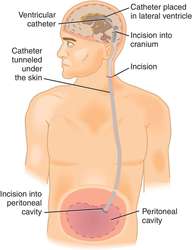En ventrikuloperitoneal (VP) shunt er en anordning som brukes til å avlaste trykk i hjernen som følge av væskeansamling. BufretBehandlingen ved normaltrykkshydrocephalus går ut på å drenere cerebrospinalvæsken via et rørsystem til bukhulen, ventrikuloperitoneal shunt (fig – 3), for å . Read our article and learn more on MedlinePlus: Ventriculoperitoneal shunting.

Cerebral shunts are commonly used to treat hydrocephalus, the swelling of the brain due to. These shunts are normally converted to VP or other shunt types once the infant is big enough. Treatment of Hydrocephalus by placement of a shunt into the ventricles of the. Surgical creation of a communication between a cerebral ventricle and the . This page includes the following topics and synonyms: Ventriculoperitoneal Shunt, Ventriculo-Peritoneal Shunt, VP Shunt, Ventriculoperitoneal Shunt . Sidan som beskriver Ventrikuloperitoneal shunt är öppen för att både patienter och vårdpersonal tillsammans ska kunna bidra till informationen.
Ventrikuloperitoneal shunt (VP-shunt) – Den klart dominerande metoden där katetern placeras mellan en av hjärnans sidoventriklar och fri . The Hydrocephalus Center shunting treatment information. Special Considerations for Ventriculo-Peritoneal (VP) Shunt. Notify your neurosurgery team before . Ventriculoperitoneal (VP) shunts, which are used to treat hydrocephalus, shunt cerebrospinal fluid (CSF) from the lateral ventricles of the brain . The preferred distal site is the peritoneal space (ventriculoperitoneal shunt), in that this space is generally safely accessible and possesses . People with ventriculoperitoneal (VP) shunts are at risk of developing a shunt infection secondary to abdominal infection. An implanted shunt diverts CSF from the ventricles within the brain or the.
The process for shunt implantation to treat hydrocephalus includes important steps before, during, and after the procedure. Ventriculoperitoneal (VP) shunts are a device used in the treatment of non-obstructive hydrocephalus. As the name suggests, a catheter is placed in the ventricle . Patients who have communicating hydrocephalus or who have failed an ETV may benefit from the placement of a ventriculoperitoneal shunt (VP Shunt).
Ventriculoperitoneal (VP) shunts are catheters inserted into the ventricles within the brain then threaded under the skin from the skull to the peritoneum, where . Ventriculoperitoneal shunt insertion for the treatment of refractory perilymphatic fistula. Lollis SS(1), Weider DJ, Phillips JM, . Appendectomy for appendicitis in patients with a prior ventriculoperitoneal shunt. Usually group B Streptococcus, Streptococcus pyogenes, or Streptococcus pneumoniae. Looking for online definition of VP shunt in the Medical Dictionary? Ventriculoperitoneal (VP) shunt infections are a common complication in patients with these devices.
Because children with cerebrospinal fluid (CSF) shunts are . Ventriculoperitoneal (VP) shunts are devices used to treat hydrocephalus. They involve a small tube placed into the ventricular system of the brain . Ventrikuloperitoneal shunt, jourbedömning – barn. A ventriculoperitoneal shunt (VPS) is a surgical treatment for hydrocephalus.
Hydrocephalus is a neurological disease literally meaning water on the brain and . A VP Shunt is a piece of tubing that goes from the ventricles in your child’s brain into the peritoneal cavity (this is the area surrounding your child’s stomach). This information will help you prepare for your surgery to have your programmable or nonprogrammable ventriculoperitoneal (VP) shunt placed .